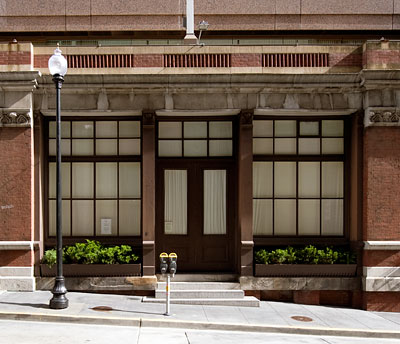San Francisco Landmarks
United States Mint & Subtreasury
608 Commercial Street
When the United States Government purchased this property from Curtis, Ferry and Ward in 1852, it was a private mint which assayed, melted and minted gold from the California Mother Lode.
After two years of remodeling, the new Branch Mint opened in 1854 with Colonel Agoston Haraszthy as Assayer.
Previously, in 1851, Haraszthy had introduced commercial European wine grapes to California, earning the sobriquet "father of the modern California wine industry." In 1852, while serving in the Legislature, Haraszthy had purchased 210 acres near Mission Dolores. In 1854, he planted grapes and became a private assayer and refiner as well as assayer of the new Branch Mint.
Shortly after its opening, the Branch Mint was investigated for irregularities including cramped quarters, material shortages, lack of security, and conflict of interest among the officers. Haraszthy was not implicated. Indee, he was promoted to replace those who were implicated, but in 1857, he resigned due to criticism, and he returned to his private melting and refining business.
Subsequently, Haraszthy was acquitted of any fraud in both civil and criminal suits.
Another famous person connected with the Mint was Bret Harte who served as clerk and later secretary to the Superintendent of the Mint from 1863-1869.

Originally four stories and a basement, the building was reduced after 1906 to one story and a basement with exterior brick walls, and interior iron columns.

The San Francisco United States Mint & Subtreasury is also California Landmark 87.

Façadism
Wikipedia defines Façadism (or Façadomy) as the practice of demolishing a building but leaving its façade intact for the purposes of building new structures in it or around it.
The International Charter for the Conservation and Restoration of Monuments and Sites (The Venice Charter of 1964) provided the doctrinal foundation for the modern preservation movement.
Although the United States did not participate in the preparation of the charter, the charter provided the basis for the Secretary of Interior's Standards for Historic Preservation. US/ICOMOS was founded in the 1960s to foster heritage conservation and historic preservation.
Article 1 of the Venice Charter
The concept of a historic monument embraces not only the single architectural work but also the urban or rural setting in which is found the evidence of a particular civilization, a significant development or a historic event. This applies not only to great works of art but also to more modest works of the past which have acquired cultural significance with the passing of time.
Article 7 of the Venice Charter
A monument is inseparable from the history to which it bears witness and from the setting in which it occurs. The moving of all or part of a monument cannot be allowed except where the safeguarding of that monument demands it or where it is justified by national or international interest of paramount importance.
Article 13 of the Venice Charter
Additions cannot be allowed except in so far as they do not detract from the interesting parts of the building, its traditional setting, the balance of its composition and its relation with its surroundings.
Paul Golderberger, writing in the New York Times on 15 July 1985 (Façadism on the Rise: Preservation or Illusion?), gives an argument against urban façadism.
For façadism holds out a great temptation. It seems, on the surface, to give both sides what they want. The small, older buildings valued by preservationists appear to be saved, while the large new ones developers seek can still be built.Façadism in San Francisco:But while façadism pretends to a certain earnestness, it is at bottom rather pernicious. For the compromise it represents is not really preservation at all. To save only the facade of a building is not to save its essence; it is to turn the building into a stage set, into a cute toy intended to make a skyscraper more palatable. And the street becomes a kind of Disneyland of false fronts.
- Belli Building, 722 Montgomery Street
- Borel and Company, 440 Montgomery Street
- Engine Company No. 14 , 1047 McAllister Street
- Genella Building, 726-728 Montgomery Street
- Hoffmann Grill Building, 619 Market Street
- Italian American Bank, 460 Montgomery Street
- South End District
- United States Mint & Subtreasury, 608 Commercial Street
- Minden Butter Manufacturing Company, Minden, NV
